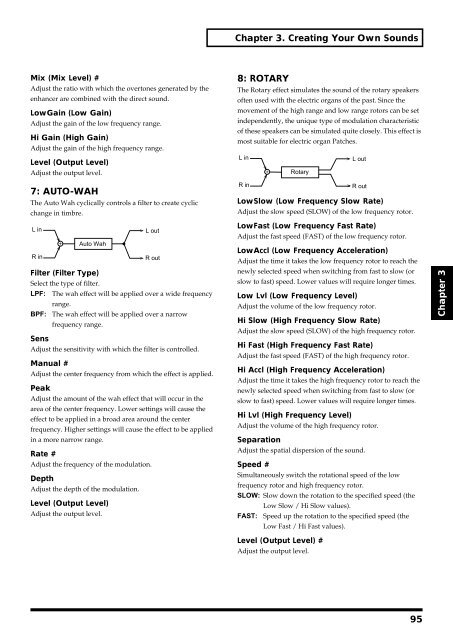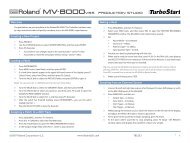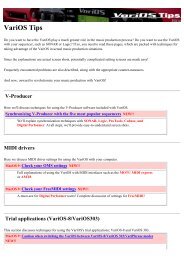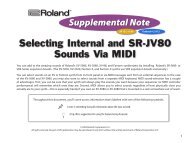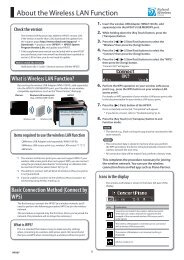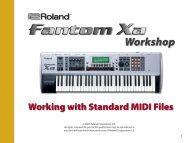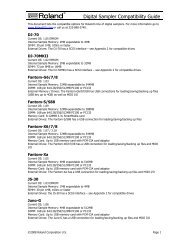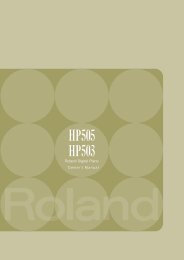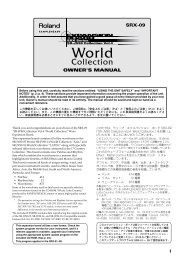You also want an ePaper? Increase the reach of your titles
YUMPU automatically turns print PDFs into web optimized ePapers that Google loves.
Chapter 3. Creating Your Own Sounds<br />
Mix (Mix Level) #<br />
Adjust the ratio with which the overtones generated by the<br />
enhancer are combined with the direct sound.<br />
LowGain (Low Gain)<br />
Adjust the gain of the low frequency range.<br />
Hi Gain (High Gain)<br />
Adjust the gain of the high frequency range.<br />
Level (Output Level)<br />
Adjust the output level.<br />
7: AUTO-WAH<br />
The Auto Wah cyclically controls a filter to create cyclic<br />
change in timbre.<br />
fig.3-54<br />
L in<br />
L out<br />
Auto Wah<br />
R in<br />
R out<br />
Filter (Filter Type)<br />
Select the type of filter.<br />
LPF: The wah effect will be applied over a wide frequency<br />
range.<br />
BPF: The wah effect will be applied over a narrow<br />
frequency range.<br />
Sens<br />
Adjust the sensitivity with which the filter is controlled.<br />
Manual #<br />
Adjust the center frequency from which the effect is applied.<br />
Peak<br />
Adjust the amount of the wah effect that will occur in the<br />
area of the center frequency. Lower settings will cause the<br />
effect to be applied in a broad area around the center<br />
frequency. Higher settings will cause the effect to be applied<br />
in a more narrow range.<br />
Rate #<br />
Adjust the frequency of the modulation.<br />
Depth<br />
Adjust the depth of the modulation.<br />
Level (Output Level)<br />
Adjust the output level.<br />
8: ROTARY<br />
The Rotary effect simulates the sound of the rotary speakers<br />
often used with the electric organs of the past. Since the<br />
movement of the high range and low range rotors can be set<br />
independently, the unique type of modulation characteristic<br />
of these speakers can be simulated quite closely. This effect is<br />
most suitable for electric organ Patches.<br />
fig.3-55<br />
L in<br />
L out<br />
Rotary<br />
R in<br />
R out<br />
LowSlow (Low Frequency Slow Rate)<br />
Adjust the slow speed (SLOW) of the low frequency rotor.<br />
LowFast (Low Frequency Fast Rate)<br />
Adjust the fast speed (FAST) of the low frequency rotor.<br />
LowAccl (Low Frequency Acceleration)<br />
Adjust the time it takes the low frequency rotor to reach the<br />
newly selected speed when switching from fast to slow (or<br />
slow to fast) speed. Lower values will require longer times.<br />
Low Lvl (Low Frequency Level)<br />
Adjust the volume of the low frequency rotor.<br />
Hi Slow (High Frequency Slow Rate)<br />
Adjust the slow speed (SLOW) of the high frequency rotor.<br />
Hi Fast (High Frequency Fast Rate)<br />
Adjust the fast speed (FAST) of the high frequency rotor.<br />
Hi Accl (High Frequency Acceleration)<br />
Adjust the time it takes the high frequency rotor to reach the<br />
newly selected speed when switching from fast to slow (or<br />
slow to fast) speed. Lower values will require longer times.<br />
Hi Lvl (High Frequency Level)<br />
Adjust the volume of the high frequency rotor.<br />
Separation<br />
Adjust the spatial dispersion of the sound.<br />
Speed #<br />
Simultaneously switch the rotational speed of the low<br />
frequency rotor and high frequency rotor.<br />
SLOW: Slow down the rotation to the specified speed (the<br />
Low Slow / Hi Slow values).<br />
FAST: Speed up the rotation to the specified speed (the<br />
Low Fast / Hi Fast values).<br />
Chapter 3<br />
Level (Output Level) #<br />
Adjust the output level.<br />
95


